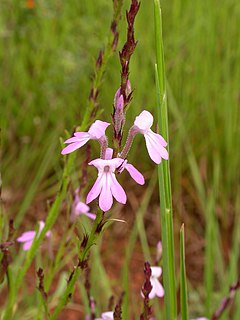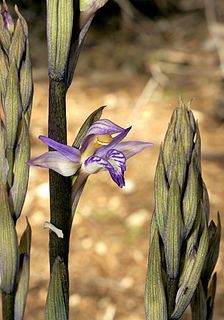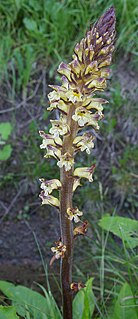
Pinus densiflora, also called the Japanese red pine, the Japanese pine, or Korean red pine, has a home range that includes Japan, the Korean Peninsula, northeastern China and the extreme southeast of Russia. This pine has become a popular ornamental and has several cultivars, but in the winter it becomes yellowish. The height of this tree is 20–35 m. The plant prefers full sun on well-drained, slightly acidic soil.

Orobanche, commonly known as broomrape, is a genus of over 200 species of small parasitic herbaceous plants, mostly native to the temperate Northern Hemisphere. It is the type genus of the broomrape family Orobanchaceae.

Cineraria is a genus of flowering plants in the sunflower family, native primarily to southern Africa with a few species farther north. The genus includes herbaceous plants and small subshrubs.

Striga, commonly known as witchweed, is a genus of parasitic plants that occur naturally in parts of Africa, Asia, and Australia. It is in the family Orobanchaceae. Some species are serious pathogens of cereal crops, with the greatest effects being in savanna agriculture in Africa. It also causes considerable crop losses in other regions, including other tropical and subtropical crops in its native range and in the Americas.

Nepenthes densiflora is a tropical pitcher plant endemic to Sumatra, where it grows at an altitude of between 1700 and 3200 m above sea level.

Geissomeria is a genus of plants in the family Acanthaceae.

Siphoneugena densiflora is a species of plant in the family Myrtaceae. It is endemic to Brazil. Typically found as a shrub up to 3 metres tall, and more rarely as a tree up to between 12 and 13 metres tall, this plant produces edible purplish-black fruit that are less than 10mm in diameter.

Orobanche minor, the hellroot, common broomrape, lesser broomrape, small broomrape or clover broomrape, is a holoparasitic flowering plant belonging to the genus Orobanche; a genus of about 150 non-photosynthetic plants that parasitize other autotrophic plants.
Orobanche pinorum is a species of broomrape known by the common name conifer broomrape. It is native to the forests of western North America, where it is a parasite growing attached to the roots of other plants, usually Holodiscus species. This plant has an erect stem with a wide, thickened base and slender top growing 10–30 centimetres (3.9–11.8 in) tall. As a parasite taking its nutrients from a host plant, it lacks leaves and chlorophyll and is brownish or yellowish in color. The inflorescence is a dense, spreading array of purple-tinged yellowish flowers 1–2 centimetres (0.39–0.79 in) long.

Orobanche ramosa is a species of broomrape known by the common names hemp broomrape and branched broomrape. It is native to Eurasia and North Africa, but it is known in many other places as an introduced species and sometimes a noxious weed.

Lumnitzera is an Indo-West Pacific mangrove genus in the family Combretaceae. An English common name is black mangrove. Lumnitzera, named after the German botanist, Stephan Lumnitzer (1750-1806), occurs in mangroves from East Africa to the Western Pacific, and northern Australia.

Spartina densiflora is a species of grass known by the common name denseflower cordgrass. It has been reclassified as Sporobolus montevidensis after a taxonomic revision in 2014, but Spartina densiflora is still in common usage. It is native to the coastline of southern South America, where it is a resident of salt marshes. It is also known on the west coast of the North America and parts of the Mediterranean coast as an introduced species and in some areas a noxious weed. In California it is a troublesome invasive species of marshes in San Francisco Bay and in Humboldt Bay, where it was introduced during the 19th century from Chile in ballast.

Orobanche rapum-genistae, the greater broomrape, is a plant species in the genus Orobanche. It is a parasitic plant, native to Europe, growing on the roots of plants in the bean family, usually common broom or European gorse.

Limodorum is a genus of myco-heterotrophic orchids. All species are temperate terrestrial plants and occur across much of Europe, North-West Africa, the Mediterranean Islands, and as far east as Iran. Plants have evolved away from photosynthesis and as a result their leaves are reduced to scales. There is still chlorophyll present but the plants are believed to be solely dependent on their fungal partner for nutrients. They spend most of their life underground as a short stem with fleshy roots, the unbranched inflorescence can appear in April to June if conditions are favourable.
Milligania is a genus of plants. It contains 5 currently recognized species, all native to Tasmania:

Orobanche hederae, the ivy broomrape, is, like other members of the genus Orobanche, a parasitic plant without chlorophyll, and thus totally dependent on its host, which is ivy. It grows to 60 cm (2 ft), with stems in shades of brown and purple, sometimes yellow. The flowers are 10–22 mm (0.4–0.9 in) long, cream in colour with reddish-purple veins.

Orobanche reticulata is a species of broomrape known by the common name thistle broomrape. It is a parasitic plant whose host is normally the creeping thistle. It is native to the lowlands of Western Europe and Central Asia, but in the United Kingdom it is a rare and protected plant, growing only in Yorkshire, on grassland sites such as Quarry Moor.
Myriopus is a genus of flowering plants in the borage and forget-me-not family Boraginaceae, native to Latin America, the Caribbean, and Florida.
Orobanche mutelii, the dwarf broomrape, is a species of plant in family Orobanchaceae. It is endemic to Malta.
Schindleria is a genus of flowering plants in the family Petiveriaceae.















